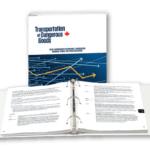
There’s a new idea in dangerous goods training that’s getting a lot of attention these days – Competency-Based Training. It’s been adopted by the air regulations under ICAO (International Civil Aviation Organization) and IATA (International Air Transport Association). And now, Transport Canada has taken its first steps to making Competency-Based Training the standard method of training for dangerous goods transport as well, as the Canadian General Standards Board (CGSB) has published a new standard introducing this new concept for the dangerous goods community.
What is Competency-Based Training?
The term “Competency-Based Training” or CBT (not to be confused with Computer-Based Training, also sometimes called CBT), can be a little confusing. According to The Glossary of Educational Reform, “Competency-based learning refers to systems of instruction, assessment, grading, and academic reporting that are based on students demonstrating that they have learned the knowledge and skills they are expected to learn as they progress through their education.” In general terms, it relies on the training provider to break the topic of training down into specific “competencies” or abilities, and focus on facilitating the students gaining these competencies. Then, an evaluation would look specifically at “can the students reliably demonstrate they are competent in these areas?” This creates a granular approach to designing and evaluating training programs.
How would this work in dangerous goods training? Well, first the employer and training provider would look at what workers would need to know to perform the tasks they have been assigned. For example, someone who packages and labels dangerous goods would have some specific things they must be able to do. They must be able to determine that they’re shipping dangerous goods, and be able to obtain the shipping description. Then, they must be able to determine what packaging they should use for the goods. They must be able to assemble that packaging correctly. Finally, they must be able to select and correctly apply the appropriate marks and labels.
Training should then be focussed on those specific skills and abilities, as they apply in the specific workplace. For example, some workplaces would expect workers to have a familiarity with using Schedule 1 of the “Transportation of Dangerous Goods Regulations” (TDGR) to obtain shipping descriptions. Others would expect the workers to refer to SDSs. Others still might have a computerized system that would provide the description upon the entry of a trade name or part number. The training should address the specifics of each workplace.
After training, of course, comes evaluation. The evaluation must provide verification that the employees have actually learned to perform the competencies adequately. So, once more, the employer and training provider must figure out how to create an evaluation system appropriate to the workplace and to the type of competencies that the workers need for their job. It could be a written or computer-based quiz, but there are other methods, such as asking the worker to perform a task involving the competencies. In the case of the packer and labeler example above, the supervisor might assign the worker a product to prepare, and keep a checklist to verify they did all the steps required.
The CGSB Standard
The standard issued by the CGSB, titled “CAN/CGSB-192.3-2020, Transportation of dangerous goods training, assessment and competency”, will eventually be used by Transport Canada to establish CBT as the minimal training requirements for dangerous goods handlers, carriers, and offerors in Canada. As its title suggests, it addresses:
- General competencies required for those involved in the transport of dangerous goods;
- How CBT should work for dangerous goods training;
- The options for assessment such as written examination, structured interview; demonstration by visual monitoring, simulation of tasks and collection of other evidence of competency in assigned tasks; and
- Employers’ record-keeping requirements.
Perhaps the most unique requirement of the standard is that “general familiarization” training – a sort of “TDG 101” that covers the basic concepts of TDG without getting into job specifics – will have to be conducted and evaluated as a separate course. The standard requires that the general awareness session be followed by an assessment that meets very exacting standards. It must:
- Include no less than 25 questions, with at least one question for each major topic;
- Have a mandatory passing score of no less than 80%; and
- Be completed by the student in no more than three attempts. If the student hasn’t passed within three attempts, he or she must go back for additional training before retaking the evaluation.
This implies clearly that the standard expects that the general awareness training is to be run separately from job-specific, at least in group settings. It would clearly be impractical to have part of a group retaking a quiz while the others wait, particularly one that requires 25 questions to complete. Also, by the reference to “25 questions,” it leaves unclear how options other than a written (or perhaps oral) quiz could be used to evaluate understanding.
Once the workers understand the general overview of how the regulations work, the training on job-specific tasks can begin. To aid in this, the standard contains a detailed breakdown of common dangerous goods jobs, such as packager, loader, and carrier, and lists the specific competencies that are associated with them. For example, a packer must be able to:
- Check for any special cases affecting the packaging;
- Apply any appropriate special provisions;
- Determine any quantity limitations for the means of transport;
- Identify international border and carrier variations;
- Select appropriate means of containment according to the standard referenced in Part 5; and
- Assemble the package correctly based on that standard.
Note that the employer could create shortcuts. For example, they could have a regulatory expert assign each product a means of containment that has been pre-approved. Then, the employee need only be competent in being able to determine what packaging has been assigned to the specific product being shipped.
The trainer can use the task listings to determine what job-specific competencies must be addressed, and then plan how to assess the success of the training afterward. Here’s where the multiple options for evaluation can really be used to come up with a system that meets the specific needs of the workplace and the workers.
Implementation of the Standard
Do you have to comply with the Competency-Based Training standard right away? The answer to that is “no,” although you could definitely start to incorporate it now as part of your training plan under TDG Part 6. (Part 6 is currently quite vague as to how training should be carried out, other than that it should result in workers being “adequately trained”.)
There are a few more steps that Transport Canada has to take to make CAN/CGSB-192.3 a legal requirement. These involve amending the TDGR to make the standard an official reference in Part 6. This is normally done by publishing a draft of an amendment in the Canada Gazette I, which will introduce the planned changes and invite public comment. Once the comment period is over, Transport Canada will make whatever changes appear necessary, and publish the finalized version in Canada Gazette II. When published, this will become an official amendment, although there is likely to be a transition period (probably one to two years) to allow companies to make relevant changes to their systems.
Will the new standard make training in Canada more effective? It will certainly require those creating training programs to take a closer look at what they’re trying to achieve. What specific competencies do their employees need to master in order to do their jobs safely and legally? On the other hand, some of the requirements seem needlessly bureaucratic, such as the requirement for “25 questions or more” on the general awareness evaluation, and the requirement to keep repeating the evaluation with new questions (and repeating the training after three failures), which would make group training logistically difficult. Perhaps a training program would start with a prerequisite online or video training on general awareness before participants can engage in the job-specific parts. Certainly, employers who use third-party training solutions will have to engage with them in much greater depth to determine how to establish competencies for job-specific functions.
Whenever it occurs, when CBT becomes mandatory, ICC Compliance Center will be here to help you, from evaluating required competencies, to general awareness training, to creating detailed job-specific programs.
If you have any questions about these upcoming changes, you can contact us, and ask for one of our Regulatory Experts. With our training experience stretching back to 1987, we’ll help you find the right solutions for your needs.
We have all the products, services and training you need to ensure your staff is properly trained and informed.
 Training Courses |
 TDG Publications |





